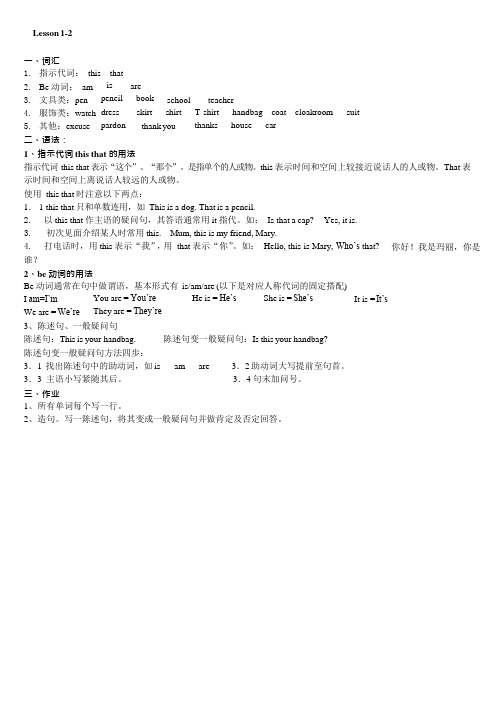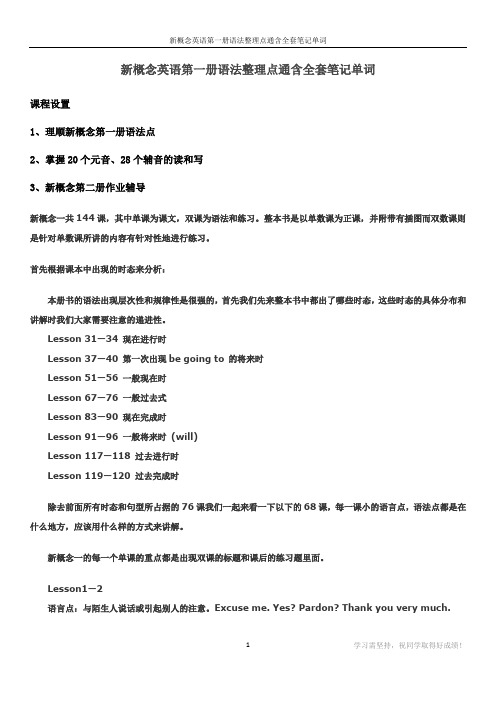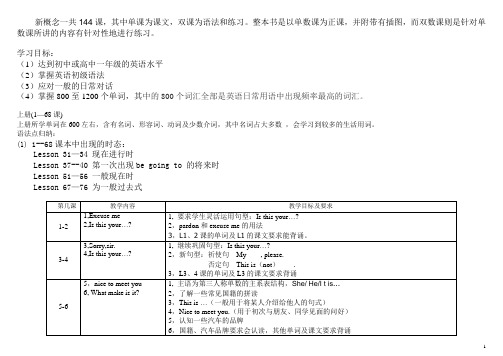(完整版)新概念第一册笔记整理
(完整版)新概念第一册知识点整理,推荐文档

1. I am Rice. (改否定句) 2. His son is a teacher. (改否定句) 3. Mr. Clinton and his wife are busy. (改为否定句) 4. Lily is seven. (改一般疑问句) 5. Are your son a student?(改错)
Lesson 1-2 小测试
Read and choose.
My name Lisa. I
from china.
A. is / am
B. are / is
C. is / are
this a car?
A. am
B. is
C. are
Is this your bag?
A. No, it is.
B. Yes, it isn’t.
2. 非常感谢。
Lesson 3-4
一、词汇 形容词性物主代词: my your his her 名词: umbrella ticket number son 形容词:new good nice 副词:here too 动词:please meet 英语中对男性及女性的称呼: Mr. Sir 二、语法:
Lesson 1-2 小测试 Read and choose. My name Lisa. I
from china.
A. is / am
B. are / is
C. is / are
this a car?
A. am
B. is
C. are
Is this your bag?
A. No, it is.
B. Yes, it isn’t.
B:
?
A: Is this your pencil?
(完整版)新概念英语第一册笔记完整版

(完整版)新概念英语第一册笔记完整版新概念英语第一册笔记完整版1)v. 原谅eg. Excuse me. 请原谅,劳驾。
2)n. 借口eg.It?s an excuse.me pron. 我(宾格:用来做宾语的。
)eg. He loves me.他爱我.eg. She cheats me.他骗我.eg. Please tell me.他告诉我.Excuse me 的用法这个短语经常被译作―对不起‖,但它并不表示你有什么过错,而是说你要打搅别人,所以常被译作―劳驾‖。
1)为了要引起别人的注意eg. Excuse me. Is this you handbag?2)要打扰某人或要打断别人话eg. Excuse me . May I ask you a question?3) 向陌生人问路eg. Excuse me. Could you please tell me the way to the railway station?4) 向某人借东西eg. Excuse me. Can I borrow your pen?5) 需要从别人身边挤过或让别人给自己让路eg. Excuse me. Could you please make some room for me?6) 要求在宴席或会议中途中离开一会儿eg. Excuse me. May I lease for a little while?sorry 用于当你做错事而向别人道歉的时候,表示―对不起‖。
1)请问几点了?eg. Excuse me. What time is it?2) 不小心把水弄到了别人的身上。
eg. Sorry. 或者I?m sorry!3) 对不起,我先失陪一下eg. Excuse me.4) 误解了别人的意思?eg. Sorry. ?yes1) adv. 是的(对一般疑问句的肯定回答)eg. Are you mad? --Yes, I am.2)经常用于应答,表示―什么事‖。
新概念英语第一册知识点总结

新概念英语第一册知识点总结新概念英语第一册知识点总结很多家长和孩子都知道新概念英语是一套权威的教材,在学习英语的过程中我们可以充分利用好这个教材的知识。
下面是店铺为大家整理的新概念英语知识点,希望对大家有用!新概念英语第一册知识1)代词及be动词主格 I we you you she/he/it they宾格 me us you you her/him/it them代词所有格 my our your your her/his/its their名词性代词 mine ours yours yours hers/his/its theirsbe动词现在时 Am are are are is arebe动词过去时 was were were were was were2)名词的复数规则变化的名词复数形式规则1 一般情况+s e.g. shell→shells toy→toys规则2 以s, x, ch, sh结尾+es e.g. fox→foxes church→churches 规则3 以o结尾+s或+es e.g. radio→radios potato→potatoes 规则4 以f, fe结尾的,变f, fe为ves e.g. life→lives half→halves 规则5 以辅音字母+y结尾,变y为i+es e.g. sky→skies study→studies3)动词的第三人称单数形式规则1 一般情况+s e.g. like-likes, look-looks规则2 以s, x, ch, sh和o结尾+es e.g. do-does, catch-catches 规则3 以辅音字母+y结尾,变y为i+es e.g. carry-carries, fly-flies4)动词现在分词规则1 一般动词加-ing e.g. look-looking, read-reading, play-playing规则2 以不发音的字母结尾的单词去e加-ing e.g. make-making, take-taking, arrive-arriving规则3 重读闭音节词结尾,即单词中只有一个元音字母,其后紧跟一个辅音字母的词,双写辅音字母再加-ing e. g. run-running, sit-sitting, get-getting, swim-swimming, stop-stopping5)动词过去式规则动词变化规则1 一般动词加-ed e.g. look-looked, watch-watched, play-played规则2 以e结尾的加-d e.g. make-maked, arrive-arrived规则3 以辅音字母y结尾的变y为i加-ed cry-cried, carry-carried 规则4 重读闭音节词结尾,即单词中只有一个元音字母,其后紧跟一个辅音字母的词,双写辅音字母再加-ed stop-stopped 过去式的读音在清辅音后面(除外)读/t/ e.g. walked, jumped在浊辅音和元音后读/d/ e.g. washed, watched在/t/,/d/后读/id/ e.g. waited, hated新概念英语基础知识点1.in+语言/颜色/衣帽等,表示使用某种语言或穿着……。
新概念英语第一册语法归纳全篇

可编辑修改精选全文完整版新概念英语第一册语法归纳新概念英语第一册语法归纳《新概念英语》作为一套世界闻名的英语教程,以其全新的教学理念,有趣的课文内容和全面的技能训练,深受广大英语学习者的欢迎和喜爱。
以下店铺为大家整理的新概念英语第一册语法归纳,欢迎阅读!新概念英语第一册语法归纳篇1感叹句感叹句:1)What +名词+主语+谓语What a beautiful girl she is!What tall buildings they are!2)How +形容词+主语+谓语How beautiful the girl is!How tall the buildings are!在口语中,感叹句的主语和谓语常常省略:What a nice present!(省略it is)How disappointed!(省略she is或其它可作本句主、谓的词语) 祈使句祈使句表示请求、命令、建议、邀请等,谓语动词一律用原型,句子中通常不用主语,句末用惊叹好或者句号,用降调。
肯定句:动词原型Come here,please.Go downstairs,please.Stand up.Sit down.Be quiet.Be careful.祈使句中如果有唤语,一定要用逗号隔开,放在句首或者句尾:Come in,Amy.Sit down here,Tom.Mary,give me a book please.否定:Don't+动词原型Don't come here.Don't sit down.Don't stand up.Don't give me it.let sb. do 让某人做Let me pass.Let us have a rest.Let's have a rest.反意疑问:Let's have a walk along the river,shall we?Let us go out for a drink,will you?so/neither的倒装倒装句:so/neither的倒装eg: He can swim. So can I.She didn't go to class. Neither did I.结构:so/neither+be+ 主语so/neither+助动词+ 主语so/neither+情态动词+ 主语助动词:一般现在时: do,does/am,is,are现在进行时: am,is,are一般过去时: did现在完成时: have,has一般将来时: will,shall过去进行时: was,were过去完成时: had过去将来时: would直接引语/间接引语如果引语的主句所用动词为过去时,那么间接引语要做相应变化:时态,人称,时间地点及指示词1)时态变化:一般现在时——一般过去时现在进行时——过去进行时一般过去时——过去完成时现在完成时——过去完成时一般将来时——过去将来时be going to——was/were going to/wouldcan--couldmay--might2)时间地点及指示词的变化:here-there,tomorrow-the next day,the following day,this-that…3)人称变化:根据句意改变人称。
新概念第一册每课知识点整理

新概念第一册每课知识点整理Lesson 1 - Excuse me!一、重点单词。
1. excuse.- 作动词,意为“原谅;宽恕”,例如:Excuse me.(打扰一下。
)- 作名词,意为“借口;理由”,如:Don't make excuses.(不要找借口。
)2. me.- 人称代词宾格,“我”,在句中作宾语,如:Give it to me.(把它给我。
)二、重点句型。
1. Excuse me!- 用于引起别人注意、请求让路、打断别人说话等场合,是比较礼貌的用法。
三、语法点。
简单的日常交际用语的使用。
Lesson 2 - Is this your…?一、重点单词。
1. pen.- 名词,“钢笔”。
2. pencil.- 名词,“铅笔”。
3. book.- 名词,“书”。
4. watch.- 名词,“手表”;也可作动词,“观看”,如:watch TV(看电视)。
二、重点句型。
1. Is this your pen?- 这是一般疑问句,其结构为“be动词(is/are等)+主语+其他”,回答可以是“Yes, it is.”或者“No, it isn't.”三、语法点。
1. 一般疑问句的构成与回答。
2. 指示代词this的用法,用来指代离说话者较近的人或物。
Lesson 3 - Sorry, sir.一、重点单词。
1. umbrella.- 名词,“雨伞”。
2. please.- 副词,用于请求别人做某事时表示礼貌,如:Please open the window.(请打开窗户。
)二、重点句型。
1. Is this your umbrella?- 同Lesson 2中的一般疑问句结构。
2. Sorry, sir.- “sorry”表示歉意,“sir”是对男性的尊称。
三、语法点。
1. 继续巩固一般疑问句。
2. 尊称“sir”的用法。
Lesson 4 - Is this your…?一、重点单词。
精心整理新概念英语第一册全套笔记(语法点+配套练习+答案共665页)

Lesson1-2Is this your handbag?一、单词分类二、课文复习Excuse me!Yes?Is this your handbag?Pardon?Is this your handbag?Yes,it is.Thank you very much三、课文重点Thank you very much.=Thanks a lot.Thank you verymuch.You’re welcome./That’s all right.Thanks a lot.四、语法解析1.主格放在句首,作主语宾格放在动词或介词后,作宾语1.I love my mother.She loves me.(I)2.We are family.(we)3.Look at them.They are listening to the teacher carefully.(they)4.Are you(you)Mr.Zhang?5.Mary is waiting for him(he).形物代后跟名词,不能单独存在1.Is this your house?(you)2.I do my homework every day.(I)3.Sally is here.That is her car.(she)4.What is your name?(you)5.Look at my(I)dress.Is it beautiful?名物代用于替代前面提到的名词,后面不再跟名词1.Whose pen is it?It’s his(he).2.My cup is red and yours(you)is blue.3.Is this your handbag?Yes,it’s mine.4.Is that your key?No,it isn’t.It’s hers(she).5.That is not my bike.Mine is new.(I)2.陈述句变一般疑问句--变化规则:1.找到be动词,大写提句首2.人称做变化:my—your,our—your3.其它部分照抄4.句号变问号练习:This is his pen.变一般疑问句Is this his pen?This is her pencil.变一般疑问句Is this her pencil?This is their car.变一般疑问句Is this their car?This is its book.变一般疑问句Is this its book?This is your car.变一般疑问句Is this your car?This is my dog.变一般疑问句Is this your dog?This is our dog.变一般疑问句Is this your dog?五、单词练习1.There is that,here is t his.2.Thanks means(意思是)t hank you.3.Thanks a lot means thank you v ery much.4.A boy,he;a girl,she;a dog,i t.5.You are my friend,I am y our friend.6.When you want to sneeze(打喷嚏),you should(应该)say excuse me.。
新概念英语第一册语法整理点通含全套笔记单词

新概念英语第一册语法整理点通含全套笔记单词课程设置1、理顺新概念第一册语法点2、掌握20个元音、28个辅音的读和写3、新概念第二册作业辅导新概念一共144课,其中单课为课文,双课为语法和练习。
整本书是以单数课为正课,并附带有插图而双数课则是针对单数课所讲的内容有针对性地进行练习。
首先根据课本中出现的时态来分析:本册书的语法出现层次性和规律性是很强的,首先我们先来整本书中都出了哪些时态,这些时态的具体分布和讲解时我们大家需要注意的递进性。
Lesson 31—34 现在进行时Lesson 37—40 第一次出现be going to 的将来时Lesson 51—56 一般现在时Lesson 67—76 一般过去式Lesson 83—90 现在完成时Lesson 91—96 一般将来时(will)Lesson 117—118 过去进行时Lesson 119—120 过去完成时除去前面所有时态和句型所占据的76课我们一起来看一下以下的68课,每一课小的语言点,语法点都是在什么地方,应该用什么样的方式来讲解。
新概念一的每一个单课的重点都是出现双课的标题和课后的练习题里面。
Lesson1—2语言点:与陌生人说话或引起别人的注意。
Excuse me. Yes? Pardon? Thank you very much.语法点:主系表结构this为主语,名词做表语1的一般疑问句以及它的肯定回答。
Is this your handbag? Yes, it is.Lesson 5—6语言点:如何介绍别人。
This is Miss Sophie Dupont. Nice to meet you.语法点:主语为第三人称单数的主系表结构。
She is French. He is German. It’s a Volvo.(L6) a/an 的使用。
Lesson 7—8语言点:如何自我介绍和相互认识。
语法点:主语为第二人称的主系表结构。
(完整版)新概念第一册每一课重点的总结

新概念一共144课,其中单课为课文,双课为语法和练习。
整本书是以单数课为正课,并附带有插图,而双数课则是针对单数课所讲的内容有针对性地进行练习。
学习目标:
(1)达到初中或高中一年级的英语水平
(2)掌握英语初级语法
(3)应对一般的日常对话
(4)掌握800至1200个单词,其中的800个词汇全部是英语日常用语中出现频率最高的词汇。
上册(1—68课)
上册所学单词在600左右,含有名词、形容词、动词及少数介词,其中名词占大多数,会学习到较多的生活用词。
语法点归纳:
(1) 1--68课本中出现的时态:
Lesson 31—34 现在进行时
Lesson 37--40 第一次出现be going to 的将来时
Lesson 51—56 一般现在时
Lesson 67—76 为一般过去式
中册(69—106课),大约有300单词,包含名词、动词、形容词、副词、介词,其中所学的动词和副词会有所增加。
课文中出现的时态有:
Lesson 67—76 为一般过去式
Lesson 83—90 为现在完成时
Lesson 91—96 为一般将来时
下册(107—144课),大约有300个单词语法点归纳:
1、L107-108形容词的比较级,最高级
2、L117-118时间状语从句和过去进行时
3、L121-122定语从句
4、L119-120 过去完成时
5、L139-140宾语从句
6、L141-144被动语态。
- 1、下载文档前请自行甄别文档内容的完整性,平台不提供额外的编辑、内容补充、找答案等附加服务。
- 2、"仅部分预览"的文档,不可在线预览部分如存在完整性等问题,可反馈申请退款(可完整预览的文档不适用该条件!)。
- 3、如文档侵犯您的权益,请联系客服反馈,我们会尽快为您处理(人工客服工作时间:9:00-18:30)。
新概念第一册1—2课文详解及英语语法课文详注 Further notes on the text1.Excuse me 对不起。
这是常用于表示道歉的客套话,相当于汉语中的“劳驾”、“对不起"。
当我们要引起别人的注意、要打搅别人或打断别人的话时,通常都可使用这一表达方式。
在课文中,男士为了吸引女士的注意而使用了这句客套话。
它也可用在下列场合:向陌生人问路,借用他人的电话,从别人身边挤过,在宴席或会议中途要离开一会儿等等。
2.Yes?什么事?课文中的 Yes?应用升调朗读,意为:“什么事?”Yes?以升调表示某种不肯定或询问之意,也含有请对方说下去的意思。
3.Pardon?对不起,请再说一遍.当我们没听清或没理解对方的话并希望对方能重复一遍时,就可以使用这一表达方式。
较为正式的说法是:I beg your pardon。
I beg your pardon? Pardon me。
它们在汉语中的意思相当于“对不起,请再说一遍”或者“对不起,请再说一遍好吗?”4.Thank you very much.非常感谢!这是一句表示感谢的用语,意为“非常感谢(你)”。
请看下列类似的表达式,并注意其语气上的差异:Thank you。
谢谢(你)。
Thanks! 谢谢!5.数字1~10的英文写法1—one 2—two 3—three 4—four 5-five6—six 7—seven 8—eig ht 9—nine 10—ten语法 Grammar in use一般疑问句一般疑问句根据其结构又分为若干种。
通过主谓倒装可将带有be的陈述句变为一般疑问句。
即将be的适当形式移到主语之前,如:陈述句:This is your watch。
这是你的手表.疑问句:Is this your watch? 这是你的手表吗?(可参见 Lessons 15~16语法部分有关 be的一般现在时形式的说明.)词汇学习 Word study1.coat n. 上衣,外套: Is this your coat?这是你的外套吗?coat and skirt〈英>(上衣、裙子匹配的)西式女套装2.dress n。
(1)连衣裙;套裙: Is this your dress? 这是你的连衣裙吗?(2)服装;衣服: casual dress 便服;evening dress 晚礼服新概念第一册3—4课文详解及英语语法课文详注 Further notes on the text1.My coat and my umbrella please. 请把我的大衣和伞拿给我。
这是一个省略形式的祈使句,完整的句子应为:Give me my coat and my umbrella, please。
口语中,在语境明确的情况下通常可省略动词和间接宾语,如:(Show me your) Ticket, please. 请出示你的票。
(Show me your)Passport, please。
请出示您的护照。
2.Here's your umbrella and your coat. 这是您的伞和大衣。
Here’s 是Here is的缩略形式。
全句原为:Here is your umbrella and your coat.缩略形式和非缩略形式在英语的书面用语和口语中均有,但非缩略形式常用于比较正式的场合。
Here’s…是一种习惯用法,句中采用了倒装句式,即系动词提到了主语之前。
又如 Here is my ticket 这句话用正常的语序时为 My ticket is here.3.Sorry = I’m sorry。
这是口语中的缩略形式,通常在社交场合中用于表示对他人的歉意或某种程度的遗憾。
Sorry 和 Excuse me 虽在汉语中都可作“对不起"讲,但 sorry 常用于对自己所犯过失表示道歉,而 Excuse me 则多为表示轻微歉意的客套语。
4.Sir,先生。
这是英语中对不相识的男子、年长者或上级的尊称。
例如:在服务行业中,服务员对男顾客的称呼通常为 sir:What can I do for you, sir? 先生,您要买什么?Thank you, sir。
谢谢您,先生。
sir 通常用于正式信函开头的称呼中:Dear sir 亲爱的先生Dear sirs 亲爱的先生们/诸位先生们Sir可用于有爵士称号者的名字或姓名之前(但不用于姓氏之前):Sir Winston Churchill 温斯顿·丘吉尔爵士Sir William Brown 威廉·布朗爵士5.数字11~15的英文写法11—eleven 12—twelve13-thirteen 14—fourteen15—fifteen语法 Grammar in use否定句否定陈述句与肯定陈述句相反,它表示“否定",并且含有一个如not 之类的否定词。
一个内含be的否定形式的陈述句,应在其后加 not,以构成否定句:肯定句:This is my umbrella. 这是我的伞。
否定句:This is not my umbrella。
这不是我的伞。
请再看课文中的这两句话:针对一般疑问句的否定的简略答语是No,it’s not/it isn't。
此处省略和非省略形式的关系为:is not =isn’t;it is = it’s.全句应为:No, it is not my umbrella. 不,它不是我的伞。
词汇学习 Word study1.suit n.(一套)衣服:Is this your suit?这是你的衣服吗?a man’s suit 一套男装;a woman’s suit 一套女装2.please:interjection(表示有礼貌地请求对方)请;烦劳:My coat and my umbrella please. 请把我的大衣和伞拿给我。
Please come in。
请进。
新概念第一册5—6课文详解及练习答案新概念第一册5-6课文详解及练习答案课文详注 Further notes on the text1.Good morning.早上好。
英语中常见的问候用句。
对此问候的回应一般也是Good morning。
根据一天中见面时间的不同还可以说Good afternoon (下午好)和 Good evening (晚上好).有时英美人见面时只简单地说一声Hello。
2.This is Miss Sophie Dupont.这位是索菲娅·杜邦小姐。
This is+姓名是将某人介绍给他人时常用的句式.课文中的例子还有:Sophie, this is Hans. 索菲娅,这位是汉斯。
And this is Naoko. 这位是直子。
3.Mr. Blake/Miss Sophie Dupont,布莱克先生/索菲娅·杜邦小姐。
英语国家中人的姓名通常由3部分组成,即:名+中间名+姓。
在一般情况下,不用中间名。
在熟悉的人中间,以名相称,而在正式的场合中常用 Mr.(先生),Mrs.(太太),Miss(小姐)或Ms.(女士)这些称呼再加上姓。
Mr.用于男士的姓之前,不能单独使用,如课文中的 Mr.Blake;而sir 一般单独使用,是对长者、上司或男顾客的尊称,如:Sorry, sir. 对不起,先生。
Miss 一般用于指未婚女子,不过有时在不知道对方是否已婚时也可使用。
4.Nice to meet you.很高兴见到你.用于初次与他人见面等非正式场合.对方的回应一般应为Nice to meet you,too(我也很高兴见到你)。
人们在正式的场合初次见面时常用:How do you do?相应的回答也是:How do you do?这是一句问候语,并非问话。
5.国籍与国家名称有别请不要将国家名称和与其对应的国籍搞混.课文的French,German,Japanese,Korean以及Chinese都是表示国籍的词。
句中表示中国国籍的词应为 Chinese 而不是 China。
语法 Grammar in use1.特殊疑问句以疑问词 who,what,when,which,why,where,whose,how 等引导的问句都叫特殊疑问句,也叫疑问词疑问句,有时还被称为wh-问句(wh—question).结构一般为:疑问词+助动词+主语+主动词等。
作为疑问词的what可以用来询问名字、国籍、工作、颜色、型号等.例如以下几个问句: What make is this car? 这辆小汽车是什么牌子的?What nationality are you? 你是哪国人?What is your job? 你的工作是干什么?What colour is it? 它是什么颜色的?What size is this skirt?这条裙子是多大号的?2.a 和 anSophie is a new student. 索菲娅是一名新学生。
This is an umbrella. 这是一把雨伞。
这两个句子中出现的a/an在英语中被称为不定冠词。
a和an在意义上没有区别。
用a/an时,我们必须记住两条基本原则:(1)a/an有不确定的意义(即所说的人、动物或东西对听者或读者来说可能是不知道的)。
(2)a/an只能用于单数可数名词之前。
此外还需注意a和an的发音:a(在平时讲话中发/+/音)用于辅音(不是辅音字母)之前;an(/+(/)用于元音(不仅仅是以元音字母a,e,i,o,u 开头的词)之前。
当我们把a或an用来说明字母表中的字母时,便会一目了然:This is a B/C/D/G/J/K/P/Q/R/T/U /V/W/Y/Z.这是一个 B/C/D/G/J/K/P/Q/R/T/U /V/W/Y/Z字母。
This is an A/E/F/H/I/L/M/N/O/S/X.这是一个A/E/F/H/I/L/M/N/O/S/X 字母。
词汇学习 Word study1.make n。
(产品的)牌子;类型,型号;式样:What make is your watch?你的手表是什么牌子的?Her dress is of Italian make。
她的连衣裙是意大利式的。
2.English adj. 英国(人)的;英格兰(人)的;英国化的:Is it an American car or an English car?它是美国车还是英国车?John is very English. 约翰生活行事非常英国化。
练习答案 Key to written exercisesLesson 6AAlice is a student. She isn’t German。
